应用化学专业英语unit-7
- 格式:ppt
- 大小:7.44 MB
- 文档页数:102

1 Unit5元素周期表As our picture of the atom becomes more detailed 随着我们对原子的描述越来越详尽,我们发现我们陷入了进退两难之境。
有超过100多中元素要处理,我们怎么能记的住所有的信息?有一种方法就是使用元素周期表。
这个周期表包含元素的所有信息。
它记录了元素中所含的质子数和电子数,它能让我们算出大多数元素的同位素的中子数。
它甚至有各个元素原子的电子怎么排列。
最神奇的是,周期表是在人们不知道原子中存在质子、中子和电子的情况下发明的。
Not long after Dalton presented his model for atom( )在道尔顿提出他的原子模型(原子是是一个不可分割的粒子,其质量决定了它的身份)不久,化学家门开始根据原子的质量将原子列表。
在制定像这些元素表时候,他们观察到在元素中的格局分布。
例如,人们可以清楚的看到在具体间隔的元素有着相似的性质。
在当时知道的大约60种元素中,第二个和第九个表现出相似的性质,第三个和第十个,第四个和第十一个等都具有相似的性质。
In 1869,Dmitri Ivanovich Mendeleev,a Russian chemist, 在1869年,Dmitri Ivanovich Mendeleev ,一个俄罗斯的化学家,发表了他的元素周期表。
Mendeleev通过考虑原子重量和元素的某些特性的周期性准备了他的周期表。
这些元素的排列顺序先是按原子质量的增加,,一些情况中, Mendeleev把稍微重写的元素放在轻的那个前面.他这样做只是为了同一列中的元素能具有相似的性质.例如,他把碲(原子质量为128)防在碘(原子质量为127)前面因为碲性质上和硫磺和硒相似, 而碘和氯和溴相似.Mendeleev left a number of gaps in his table.Instead of Mendeleev在他的周期表中留下了一些空白。
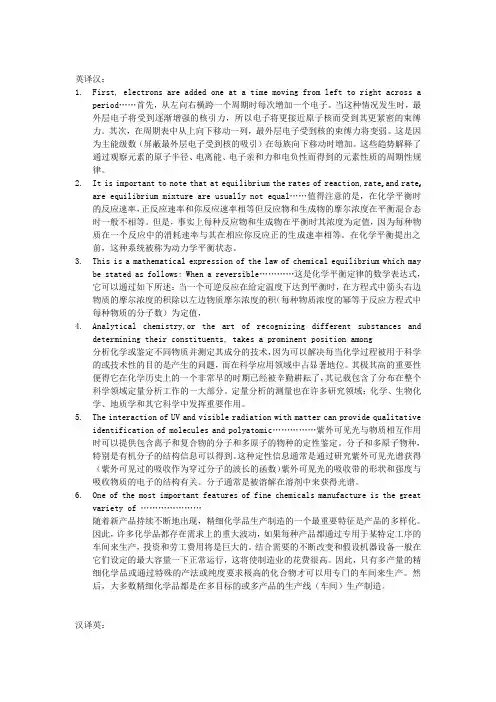
英译汉:1.First, electrons are added one at a time moving from left to right across aperiod……首先,从左向右横跨一个周期时每次增加一个电子。
当这种情况发生时,最外层电子将受到逐渐增强的核引力,所以电子将更接近原子核而受到其更紧密的束缚力。
其次,在周期表中从上向下移动一列,最外层电子受到核的束缚力将变弱。
这是因为主能级数(屏蔽最外层电子受到核的吸引)在每族向下移动时增加。
这些趋势解释了通过观察元素的原子半径、电离能、电子亲和力和电负性而得到的元素性质的周期性规律。
2.It is important to note that at equilibrium the rates of reaction,rate r and rate fare equilibrium mixture are usually not equal……值得注意的是,在化学平衡时的反应速率,正反应速率和你反应速率相等但反应物和生成物的摩尔浓度在平衡混合态时一般不相等。
但是,事实上每种反应物和生成物在平衡时其浓度为定值,因为每种物质在一个反应中的消耗速率与其在相应你反应正的生成速率相等。
在化学平衡提出之前,这种系统被称为动力学平衡状态。
3.This is a mathematical expression of the law of chemical equilibrium which maybe stated as follows: When a reversible…………这是化学平衡定律的数学表达式,它可以通过如下所述:当一个可逆反应在给定温度下达到平衡时,在方程式中箭头右边物质的摩尔浓度的积除以左边物质摩尔浓度的积(每种物质浓度的幂等于反应方程式中每种物质的分子数)为定值,4.Analytical chemistry,or the art of recognizing different substances anddetermining their constituents, takes a prominent position among分析化学或鉴定不同物质并测定其成分的技术,因为可以解决每当化学过程被用于科学的或技术性的目的是产生的问题,而在科学应用领域中占显著地位。

大学应用化学英语教材The Importance of Applied Chemistry in Modern SocietyIn today's rapidly advancing world, the field of applied chemistry plays a vital role in various industries and everyday life. As technology continues to evolve, the demand for professionals equipped with a solid foundation in applied chemistry grows. For this reason, the development of an effective and comprehensive English textbook tailored specifically for university students studying applied chemistry is necessary. In this article, we will explore the key components and structure that should be included in a top-notch applied chemistry English textbook.1. IntroductionThe textbook should begin with an introduction that highlights the importance of applied chemistry in society. It should emphasize the real-world applications of chemistry, such as drug discovery, materials engineering, environmental protection, and food production. This section should provide students with a clear understanding of the relevance and significance of studying applied chemistry.2. Basic Principles of Applied ChemistryThis section is dedicated to covering the fundamental principles of applied chemistry. It should include topics such as atomic structure, chemical bonding, stoichiometry, and reaction kinetics. The content should be concise and easy to comprehend, with well-organized tables, figures, and diagrams to aid understanding.3. Laboratory TechniquesA vital component of applied chemistry is practical laboratory work. Thus, the textbook should include a section dedicated to laboratory techniques commonly used in the field. This section should cover safety protocols, experimental procedures, data analysis, and proper documentation. It should provide students with the necessary skills to conduct experiments effectively and accurately.4. Organic ChemistryOrganic chemistry is a crucial aspect of applied chemistry, as it deals with the study of carbon-based compounds. This section should cover topics such as functional groups, nomenclature, reaction mechanisms, and synthetic methods. Emphasis should be placed on the application of organic chemistry in pharmaceuticals, polymers, and agricultural chemicals.5. Analytical ChemistryAnalytical chemistry focuses on the identification and quantification of chemical compounds. In this section, students should learn about various analytical techniques such as spectroscopy, chromatography, and electrochemistry. Practical examples and case studies should be included to demonstrate the application of analytical chemistry in environmental analysis, forensic science, and quality control.6. Inorganic ChemistryInorganic chemistry is the study of non-carbon-based compounds. This section should cover topics such as periodic trends, coordination compounds, and transition metals. Students should gain an understanding of theapplications of inorganic chemistry in materials science, catalysis, and energy production.7. Physical ChemistryPhysical chemistry combines the principles of physics and chemistry to study the properties and behavior of matter. This section should cover topics such as thermodynamics, quantum mechanics, and chemical kinetics. Students should learn about the application of physical chemistry in fields like nanotechnology, energy storage, and molecular modeling.8. Environmental ChemistryThe textbook should include a dedicated section on environmental chemistry, as the protection and sustainability of the environment are pressing global concerns. This section should cover topics such as air and water pollution, greenhouse gases, and waste management. Students should gain insights into how chemistry can contribute to environmental conservation and remediation.9. Case Studies and Practical ApplicationsTo enrich students' learning experience, the textbook should incorporate case studies and practical applications throughout the content. These examples should showcase how applied chemistry principles are utilized in real-life scenarios. By analyzing and discussing these case studies, students can better understand the practical implications of their knowledge.10. Review Questions and ExercisesFinally, the textbook should include review questions and exercises at the end of each chapter to reinforce understanding and facilitate self-assessment. These questions should cover a wide range of difficulty levels, allowing students to test their knowledge and apply what they have learned.ConclusionIn conclusion, a high-quality English textbook for university students studying applied chemistry should incorporate an engaging introduction, cover the fundamental principles of chemistry, provide comprehensive laboratory techniques, delve into organic, analytical, inorganic, and physical chemistry, address environmental concerns, include case studies and practical applications, and offer review questions and exercises. By encompassing these components, the textbook can effectively equip students with the knowledge and skills needed to excel in the field of applied chemistry and contribute to the advancement of society.Word Count: 801 words。

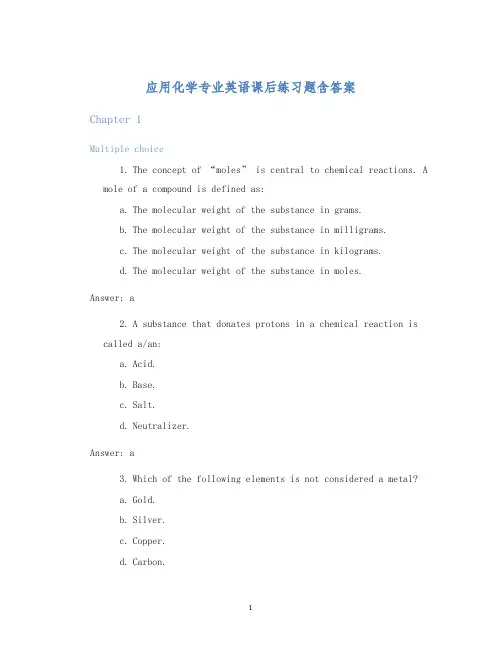
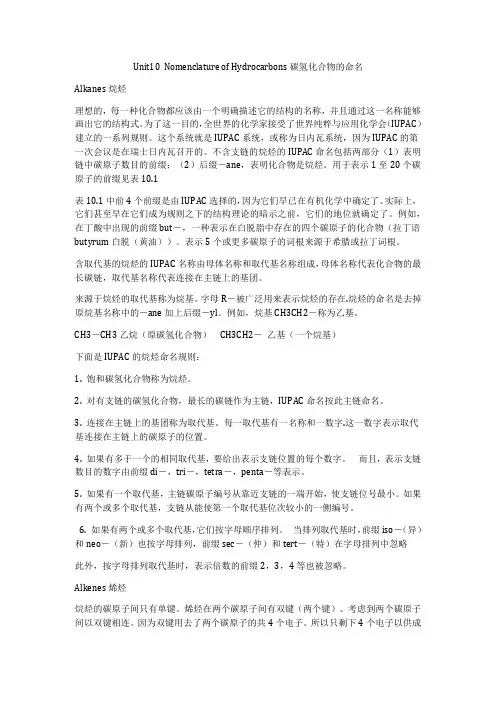
Unit10 Nomenclature of Hydrocarbons碳氢化合物的命名Alkanes烷烃理想的,每一种化合物都应该由一个明确描述它的结构的名称,并且通过这一名称能够画出它的结构式。
为了这一目的,全世界的化学家接受了世界纯粹与应用化学会(IUPAC)建立的一系列规则。
这个系统就是IUPAC系统,或称为日内瓦系统,因为IUPAC的第一次会议是在瑞士日内瓦召开的。
不含支链的烷烃的IUPAC命名包括两部分(1)表明链中碳原子数目的前缀;(2)后缀-ane,表明化合物是烷烃。
用于表示1至20个碳原子的前缀见表10.1表10.1中前4个前缀是由IUPAC选择的,因为它们早已在有机化学中确定了。
实际上,它们甚至早在它们成为规则之下的结构理论的暗示之前,它们的地位就确定了。
例如,在丁酸中出现的前缀but-,一种表示在白脱脂中存在的四个碳原子的化合物(拉丁语butyrum白脱(黄油))。
表示5个或更多碳原子的词根来源于希腊或拉丁词根。
含取代基的烷烃的IUPAC名称由母体名称和取代基名称组成,母体名称代表化合物的最长碳链,取代基名称代表连接在主链上的基团。
来源于烷烃的取代基称为烷基。
字母R-被广泛用来表示烷烃的存在.烷烃的命名是去掉原烷基名称中的-ane加上后缀-yl。
例如,烷基CH3CH2-称为乙基。
CH3-CH3乙烷(原碳氢化合物)CH3CH2-乙基(一个烷基)下面是IUPAC的烷烃命名规则:1. 饱和碳氢化合物称为烷烃。
2. 对有支链的碳氢化合物,最长的碳链作为主链,IUPAC命名按此主链命名。
3. 连接在主链上的基团称为取代基。
每一取代基有一名称和一数字.这一数字表示取代基连接在主链上的碳原子的位置。
4. 如果有多于一个的相同取代基,要给出表示支链位置的每个数字。
而且,表示支链数目的数字由前缀di-,tri-,tetra-,penta-等表示。
5. 如果有一个取代基,主链碳原子编号从靠近支链的一端开始,使支链位号最小。


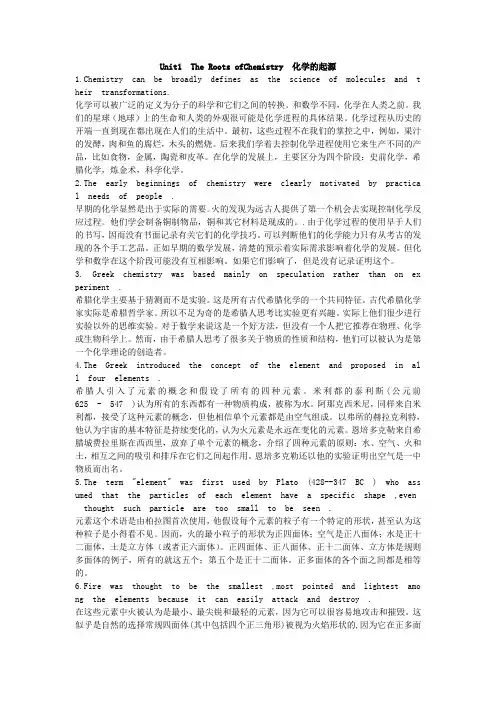
Unit1 The Roots ofChemistry 化学的起源1.Chemistry can be broadly defines as the science of molecules and their transf ormations.化学可以被广泛的定义为分子的科学和它们之间的转换。
和数学不同,化学在人类之前。
我们的星球(地球)上的生命和人类的外观很可能是化学进程的具体结果。
化学过程从历史的开端一直到现在都出现在人们的生活中。
最初,这些过程不在我们的掌控之中,例如,果汁的发酵,肉和鱼的腐烂,木头的燃烧。
后来我们学着去控制化学进程使用它来生产不同的产品,比如食物,金属,陶瓷和皮革。
在化学的发展上,主要区分为四个阶段:史前化学,希腊化学,炼金术,科学化学。
2.The early beginnings of chemistry were clearly motivated by practical needs of people .早期的化学显然是出于实际的需要。
火的发现为远古人提供了第一个机会去实现控制化学反应过程。
他们学会制备铜制物品,铜和其它材料是现成的。
.由于化学过程的使用早于人们的书写,因而没有书面记录有关它们的化学技巧。
可以判断他们的化学能力只有从考古的发现的各个手工艺品。
正如早期的数学发展,清楚的预示着实际需求影响着化学的发展。
但化学和数学在这个阶段可能没有互相影响。
如果它们影响了,但是没有记录证明这个。
3. Greek chemistry was based mainly on speculation rather than on experiment . 希腊化学主要基于猜测而不是实验。
这是所有古代希腊化学的一个共同特征。
古代希腊化学家实际是希腊哲学家。
所以不足为奇的是希腊人思考比实验更有兴趣。
实际上他们很少进行实验以外的思维实验。
对于数学来说这是一个好方法,但没有一个人把它推荐在物理、化学或生物科学上。
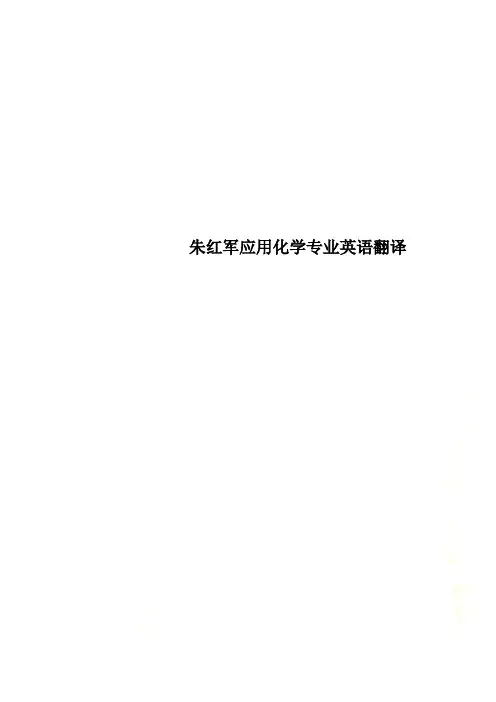
朱红军应用化学专业英语翻译CONTENTSUnit 1 Scientific Paper and LiteratureLesson 1 Writing a Scientific PaperThis chapter is a general guide to writing a scientific paper. Specific guidelines for text length, preparation of figures and tables, and instructions on how to submit your paper differ from journal to journal and publisher to publisher. For ACS journals and special publications, read the Guide, Notes, Notice, or Instructions for Authors that appear in each publication's first issue of the year and on the World Wide Web at .For ACS books, consult the brochure “How To Prepare Your manuscript for the ACS Symposium Series” or “Instructions for Authors”, available from the Books Departmentor on the World Wide Web at the same address. 译文:这一章节是写科学论文一个总的指导。
包括对于文章长度要求,数字和图表的制备,还有向不同杂志和出版商提交论文的说明指导方针。
对于美国化学学会杂志和特殊的出版物,请阅读出现在每年第一期和全球网上对于作者的指南,注释,公告和说明。

应用化学专业英语Cu—copper Fe—iron Hg—mercury Na—sodium K—potassium Ag—silverNaOH—sodium hydroxide KOH—potassium hydroxide Fe(OH)2—iron(Ⅱ)hydroxide Fe(OH)3—iron(Ⅲ)hydroxide NH4OH—ammonium hydroxideK3[Fe(CN)6]—potassium hexacyanoferrate(Ⅲ)K4[Fe(CN)6]—potassium hexacyanoferrate(Ⅱ)Ⅰ.Name the following1.(NH4)2CO3Ammonium carbonate2.N2O Nitrous Oxide3.H2SO4Sulfuric acid4.P4O6Phosphorus(Ⅲ)trioxide5.Al2O3Aluminium oxide6.SnCl4Tin(IV)chloride7.KHSO4Potassium hydrogen sulfate8.Cu2S Copper(Ⅰ)sulfide9.HClO4Perchloric acid10.BaCl2Barium chloride11.P4O10Phosphorus(Ⅴ)pentoxide12.NaH Sodium hydride13.Ca(MnO4)2Calcium permanganate14.PF5Phosphorus pentafluoride15.(NH4)2HPO4Diammonium hydrogen phosphateⅡ.Give formulas for the following1.ammonium sulfate(NH4)2SO42.barium iodide BaI23.iron(Ⅱ)sulfate Fe2SO44.potassium permanganate KMnO45.copper(Ⅱ)oxide CuO6.carbonic acid H2CO3Melting point 熔点boiling point 沸点1.Which particles play the most active role in chemical bonding?(a)electrons (b)neutrons (c)protons (d)valence electrons2.An ionic bond is formed when electrons are:(a)completely destroyed (b)compeltely transferred (c)divied (d)equally shared3.Due to the that Ionic compounds have strong intermolecular forces they are at room temperature.(a)bonded covalently (b)gases (c)liquids(d)solids 1-butene trans -2-butenecis -2-butene iso -butene (E )-2-butene (Z )-butene 2-methylpropene1.Draw structure that correspond to the following names.(a)2,2-dimethylpentane (b)4-isobutyl-2,5-dimethylheptane (c)(Z)-3-menthyl-2-octene (d)(2R,3S)-2,3-pentanediol2.Give the IUPAC name for each of the following structures.(e)(f)(E)-1-methyl-4-ethylcyclohexane(g)(h)(S)-2-chloro-butyraldehyde (2R,3R)-2,3-dichlorobutyric acid补充:(E)-2-chloro-3-methyl-2-octene Nucleophile亲核试剂carbocation碳阳离子Compressible可压缩的incompressible不可压缩的1.A chemical system can be studied from either a or a(n)viewpiont.(A)physical...chenical(B)molecual...atomic (C)Microscopic...macroscopic(D)Mechanic...kinetic2.Is a macroscopic science that studies the interrelationships between the various equilibrium properties of a stystem.(A)Kinetics(B)Thermodynamics (C)Statistical mechanics(D)Quantum chenistry3.In,the molecular and macroscopic levels are related to each other.(A)quantum(B)statistical(C)thermodynamics(D)kinetics4.thermodynamics studies.(A)heat,work,energy,and the changes they produce in the states of systems(B)The relationships between the molecules of a system(C)heat,work,temperature,and the energy they produce in the states of systems(D)heat,energy,and work5.For a(n)system,neither matter nor energy can be transferred between system and surroundings.(A)closed(B)open(C)isolated(D)none of the aboveⅠ.Translate the following from English into Chinese.(1)pollution of the atmosphere(2)nondegradable pollutant大气污染不可降解污染物(3)harmless pollutant(4)interacting chemicals无害污染物相互作用的化学物质(5)threshold level(6)sound pressure level限定值,阈值声压水平(7)speech interference(8)transmission path 语音干扰传输途径Translate the following from Chinese into English.(1)定性分析qualitative analysis (2)分析物analyte (3)准确度accuracy (5)反应速率reaction-rate (5)解吸附作用deserption (6)吸附absorption conduction 热传导convection 对流radiation 辐射Balance and classify each of the following chemical equations as a (1)combination reactions ,(2)decomposition reaction ,(3)displacement reaction ,or (4)partner-exchange reaction.(a))()(2243l O H s Fe H O Fe +→+)(4)(342243l O H s Fe H O Fe +→+displacement reaction 置换反应(b))()()(23g O s KCl s KClO +→)(3)(2)(223g O s KCl s KClO +→decomposition reaction 分解反应(c)steam and hot carbon react to form gasecous hyfrogen and gaseous carbon monoxide.)()()()(22g CO g H s C l O H +→+displacement reaction 置换反应(d))()()(4272aq HClO g O H g O Cl →+)(2)()(4272aq HClO g O H g O Cl →+combination reactions 化合反应(e))()()(22aq HBrO aq HBr O H l Br +→+)()()(22aq HBrO aq HBr O H l Br +→+decomposition reaction 分解反应(f))()()()()(43442243aq PO H s CaSO aq SO H s PO Ca +→+)(2)(3)(3)()(43442243aq PO H s CaSO aq SO H s PO Ca +→+partner-exchange reaction 复分解反应(g)Potassium reacts with water to give aqueous potassium hydroxide and gaseous hydroxide.)()(2)(2)(222g H aq KOH l O H s K +→+displacement reaction 置换反应(h)Solid magnesium carbonate decomposes to form solid magnesium oxide and gaseous carbon monoxide.)()()(23g CO s MgO s MgCO +→decomposition reaction 分解反应Abstract 摘要Results and discussion 结果与讨论Experimental实验References参考文献E-factor影响因素Journal of the American Chemical Society美国化学会志Journal of the Chemical Society化学会志Journal of Organic Chemistry有机化学杂志Tetrahedron四面体'\.._/ ( Wb川ache mical reaction?Acherr山al react i on occurs when subs'孟忘"(tlie reactants) collide (碰撞) with enough energy to rearrange to form different compounds (由e produc时. η1e change in energy由at occurs when a reaction take place is described by thermodynamics (热力学) and the rate or speed at which a reaction occ u rs is described by kfaetics (动力学) . Reactions in which the reactants and produc臼coexist are considered to be in equ山brium (处于平衡). A chemical equation consists of the chemical formula (化学式) of the reactants,且目the chemical formula of the products. The two are separated by an 一一- usually read as ”yielas·’and each chemical formula is separated from others by a plus sign (加号) . Sometimes a triangle is drawn over the arrow symbol to denote energy must be added to the substances for the reaction to begin. Each chemical formula may be preceded by a scalar (数量的) coefficient ind i cating the proportion (比例) of that substance necessary to produce the reaction in formula. For instance, the formula for the burning of methane (C比+ 202 →C02 + 2H20) indicates that twice as much 02 as C比is needed, and when they react, twice as much H20 as C02 will be produced.η1is is because during the reaction, each atom of carbon needs exactly two atoms of oxygen to combine with, to produce the C02, and every two atoms of hydrogen need an atom of oxygen to combine with to produce the H20. If the proportions of t he reactants are not respected, when they are forced to react, either not all of the substanc e used will participate in the react i on, or the react i on that will take p l ace will be different from the one noted in the equation.。
应用化学专业英语第二版万有志主编版(课后答案和课文翻译)If the mass of a 12C atom is exactly 12 amu,then the mass of a 1H atom to five significant figures must be 1.0078 amu. 12 amu x 0.083986 = 1.0078 amu(2)First we calculate k and then use the first-order rate equation.[][]()()404340.6931.2110/5730log2.3031.000 1.2110/log0.477 2.3032.303log 2.09 6.11061001.2110/k yryrA ktA yrt t yr yr---==⨯=⨯===⨯=⨯The bone was tossed away (more precisely, the animal whose bone was died) about 6100 years ago, or about 4100 B.C. We can thus be sure that a village was in existence at that place at that time.Unit 7 The Nomenclature of Inorganic SubstancesI. Comprehension1.A2.B3.C4.C5.BII. Give the systematic name for the followingammonium ion ; copper(II) ion ; strontium ion; Ccopper(I) ion; iron(II) ion; zinc ion; hydrogen ion; lead((II) ion; aluminum;silver ion; magnesium ion; chromium(III) ion; Barium ; Manganese(II) ion; iron(III) ion; calcium ion; mercury(II) ion; chromium(II) ion; tin(II) ion.carbon monoxide; ditrogen trioxide; carbon dioxide; diphosphorus pentoxide; sulfur trioxide; dichlorine heptoxidearsenate ion; sulfite ion; hydride ion; arsenite ion; bromide ion; hydroxide ion; phosphate ion; chlorate ion; hypochlorite ion; phosphate ion; chloride ion; iodate ion; carbonate ion; chlorite ion; nitrate ion;chromate ion; cyanide ion; iodide ion;dichromate ion; fluoride ion; nitrate ion;oxide ion; hydrogen carbonate ion; nitrite ion;sulfide ion; hydrogen sulfate ion; perchlorate ion;sulfate ion; hydrogen sulfite ion; permanganate ion.III. Complete the table.Formula Old name SystematicnameFeO iron (II) oxide Fe2O3iron (III) oxide Sn(OH)2tin(II)hydroxideSn(OH)4tin(IV)hydroxideHg2SO4mercury (I)sulfateHgSO4mercury (II)sulfate NaCLO sodiumhypochloriteK2Cr2O7potassiumdichromateCu3(AsO4)2copper(II)arsenateCr(C 2H 3O 2)3 chromium(IV) acetateIV . Acid names may be obtained directly from its acid ion by changing the name of the acid ion (negative ion). Use the rule to give the name of the following acid. Formula of acid Old name Name of acid H 2CO 3 carbonic acid HClO 2 chlorous acid HClO 4 perchloric acid HCN hydrocyanic acid HBr hydrobromic acid H 4SiO 4 silicic acid H 3AsO 4 arsenic acid V . Complete the sentences with the proper form of the word given at the end of the sentence.1.is altered;2.To illustrate3.indicates4.should expect5.would cancel6. are pulled7.depend on8.are; referred9.formed 10.have discussed VI. Translation1. Matter can neither be created nor be destroyed/eliminated.2. It is necessary that a scientist must know how to use fingures to get an accutate answer to question.3. Any substance is made of atoms whether it is solid, liquid or gas.4. The experiment was successful. It ’s results was the same as what we had expected.5. It will not be long before we finish the experiment.VII. Write equations for the following acid-base reactions. Use the information in inorganic textbook to predict whether the equilibrium will favor the reactants or the products. (Partially Solved)Solutin to (a): Cyanide is the conjugate base of HCN. It can accept a proton from formic acid:COHHO +CN C OH OC NH +formic acid stronger acid cyanidestronger base formate weaker baseweaker acidReading from inorganic textbook, formic acid (p K a =3.76) is a stronger acid than HCN (p K a =9.22), and cyanide is a stronger base than formate. The products (weaker acid and base) are favored. …………..VIII. Write equations for the net reactions which occur when the following materials are added to a sodium-ammonia solution.Answer: (1) 2CH3GeH3 + 2e am-→ H2 + 2CH3GeH2-(2) I2 + 2e am-→ 2I-(3) (C2H5)2S + 2e am- + NH3 → C2H5S- + C2H6 + NH2-Unit 10 Nomenclature of HydrocarbonsI. Comprehension1.C2.D3.B4.A5.B6.BII. Name the following compounds by the IUPAC system1 CH3(CH2)nCH3 (n=2, 3, 4, 6, respectively) butane, pentane, hexane,octane2 (CH3)2-CH2-CH2-CH2-CH32-methylpentane3 (CH3)3C-CH2-CH(C2H5)-CH2-CH34-ethyl-2,2-dimethylhexane5-isopropyl-2-methyloctane4 (CH3)2CH-CH2CH2-CH(CH2CH2CH3)-CH(CH3)24-isopropyl-4-propylheptane 5 CH3-CH2-CH2-C(CH2CH2CH3)2-CH(CH3)26 ◇-CH2-CH(CH3)2isobutylcyclobutane7 CH2=C(C2H5)(CH(CH3)2) 2-ethyl-3-methyl-1-butene8 CH3-CH2-CH=CH-CHCl-CH32-chloro-3-hexene9 CH3-CH(CH3)-CH(C2H5)-C≡C-CH34-ethyl-5-methyl-2-hexyneCH2=CH-C≡CH 1-buten-3-yne11(CH3)2CH-CH2CH(OH)CH34-methyl-2-pentanol12CH3CH2CH=CHCH(OH)CH33-hexen-2-ol13(CH3)3C-OH 2-methyl-2-propanol14(CH3)3C-OCH2H52-ethoxy-2-methylpropane15(CH3)2CH-CH2-O-C2H51-ethoxy-2-methylpropane16(CH2OH)21,2-ethanediol17CH3-CH(OH)-CH2(OH) 1,2-proanediol18CH2(OH)-CH(OH)-CH2(OH) 1,2,3-propanetriol19CH3CH2NH2aminoethane2 0 CH3CH2CH2CH(CH3)CH-NH-CH3N-methyl-1-amino-2-methylpentaneIII. Draw structures for the following compounds.1 3-octene C-C-C=C-C-C-C-C2 3-methy-2-heptene3 cyclohexene4 2-pentyne C-C≡C-C-C5 3,3-dimethylhexyne6 3-bromotolueneCH3Br7 vinyl chloride C=C-Cl8 acetylene C≡C9 para-dichlorobenzeneCl Cl10 m-chlorobromobenzeneBrCl11 toluene CH312 chlorobenzene Cl13 1,2-dibromobenzeneBrBr14 naphthalene15 anthracene16 phenanthrene17 2-methyl-1-propanol C CC OHC18 Cyclohexanol OH19 Methoxyethene C C O C20 trans-2-ethoxycyclohexanol OHOC2H5IV. Decide which item best completes each unfinished sentence.1.A2.A3.B4.CV. Each of the following names is incorrect. Draw the structure represented by the incorrect name (or a consistent structure if the name is ambiguous), and give your drawing the correct name.(…………)Unit 11 Carboxylic Acids and Their DerivativesI. Comprehension1.B2.B3.C4.D5.A6.CII. Fill in the blanks with the phrases given below.1.brought out2.dozen or so; put together3.are made of ;divided by4.are different from5.on the contrary; consist of6.summed up7.stand for8.such as9.are; dependent on 10.break down intoIII. Put in proper prepositions or adverbs into the blanks.1.with; as2.to3.about4.from5.intoIV. Translation1. Similarly, solvent also may not be liquid matter but the others2. A graph plotting solubility against temperature is called a solubility curve. ( The curve plot drawn (made / produced) by solubility as one coordinate and temperature as another coordinate is called solubility curve.)3. Air is mixture of gases , the most abundant of which is nitrogen in the form of N2 (molecules).4. The direction of the reaction and the position of the equilibrium may also be affected by the temperature, pressure, and other conditions.5. Hydrogen has a great affinity for oxygen and easily combines with it to form water.V. Translation玻意尔(Bohr)模型提出不久后,人们就发现原子中的电子比Bohr提出的模型要复杂得多。
Unit 1 The Rootsof Chemis tryI. Compre hensi on.1.It can be inferred from this articl e whichone of the followi ng itemsi s not mainly basedon practi c al use C. Greekchemis try2. It was B. Empedo cless who firsti ntrod ucedthe idea that all things are not formed from just one elemen t.3. In the develo pment of Greekchemis t ry, D. Democri tus was the first one defini tingthe ultimatelyconsti tuent s of matter?4. Accord i ng to Plato, thereare B. 4 ―elemen ts‖ whosefacesare consti tuted by regula r polygons.5. In the last paragraph,authors thinkthat experi ment DD.can deal with the reacti ons by whichone substa n ce is converted into anothe rII. Make a senten ce out of each item by rearra nging the wordsin bracke ts.1.The purifi catio n of an organi c compou nd is usuall y a matter of consid erabl e diffic ulty, and itis necess ary to employ variou s method s for this purpos e.2.Scienc e is an ever-increa singbody of accumu lated and system atize d knowle dge and is also anactivi ty by whichknowle dge is genera ted.3.Life, afterall, is only chemis try, in fact, a smallexampl e of chemis try observ ed on a si nglemundan e planet.4.People are made of molecul es; some of the molecul es in people are rather simple wherea sothers are highly comple x.5.Chemist ry is ever presen t in our livesfrom birthto deathbecause withou t chemis t ry therei sneithe r life nor death.6.Mathem atics appears to be almost as humanki nd and also permea tes all aspect s of humanlife,althou gh many of us are not fullyawareof this.III. Transl ation.1.(a)化学过程;(b)自然科学;(c)蒸馏技术(a) chemic al proces s (b) natura l science (c) the techni que of distil latio n2.正是原子构成铁、水、氧等。
应用化学专业英语朱红军第二版课文翻译Unit 7 Physical ChemistryPhysical chemistry is the study of the physical basis of chemical systems and processes. Modern physical chemistry is firmly grounded upon physica. Important areas of study include chemical thermodynamics, chemical kinetics, quantum chemistry, statistical mechanics, electrochemistry, surface and solid state chemistry, and spectroscopy.物理化学是对化学系统和过程的物理基础的研究。
现代物理化学以物理为基础。
重要的研究领域包括化学热力学、化学动力学、量子化学、统计力学、电化学、表面和固体化学以及光谱学。
We have repeatedly referred to the energy effects accompanying chemical and physical changes. Thermodynamics is the study of these energy effects in particular, it summarizes the relations between heat, work, and other forms of energy that are involved in all types of changes. The laws of thermodynamics can be used to predict whether a particular chemical or physical transformation is theoretically possible under a given set of conditions. Furthermore, if a study shows that a desired change will not occur under the conditions assumed, thermodynamic principles can be used to determine how the conditions can be altered to make the change theoretically possible.我们一再提到伴随着化学和物理变化的能量效应。
PART TWO THE FUNDATIONS OF CHEMISTRYUnit7Chemical Bonds化学键There are approximately 100 chemical elements.世界上大概有100种元素。
There are millions of chemical compound, and about 600000 new compounds are prepared every year.现有数百万种化合物,而且每年有60万种新化合物被合成出来。
To form these compounds, atoms of different elements must be held together in specific combinations.be held togetherin specific combinations 以特定的方式为了合成这些化合物,不同种类的原子必须以特定方式结合在一起。
Chemical bonds are the forces that maintain these arrangements.That引导定语从句,修饰forces化学键是保持这种结合状态的力。
Chemical bonding also plays a role in determining the state of matter.plays a role 起作用化学键同时在决定物质状态方面也起作用。
At room temperature, water is a liquid, carbon dioxide is a gas, andtable salt is a solid because of differences in chemical bonding.在室温下,水是液体,二氧化碳是气体,晶体盐是固体,是由于化学键的不同。
As scientists developed an understanding of the nature of chemical bonding, they gained the ability to manipulate the structure of compounds.As引导原因状语从句to manipulate the structure of compounds不定式短语做宾补随着化学家对化学键认识的发展,他们获得了控制化合物结构的能力。
应用化学专业英语第二版课后练习题含答案Chapter OneMultiple Choice Questions1.The scientific method of problem solving consists of___________. A. observation, experimentation, hypotheses, theory B.experimentation, observation, theory, hypotheses C. observation, hypotheses, theory, experimentation D. hypothesis, theory,experimentation, observationAnswer: A2.Which of the following is NOT one of the key steps involvedin the scientific method? A. Formulating hypotheses B. Building experiments C. Rejecting hypotheses D. Proving hypothesesAnswer: D3.Which of the following is a physical property? A. Density B.Flammability C. Reaction with acid D. RustingAnswer: A4.Which subatomic particle carries a positive charge? A.Proton B. Neutron C. Electron D. AtomAnswer: A5.Which of the following is NOT a chemical change? A. Burningof wood B. Digestion of food C. Melting of ice D. Rusting of ironAnswer: CShort Answer Questions1.What is the difference between a chemical and physicalchange? Answer: A physical change is a change in the physicalproperties of a substance, whereas a chemical change is a change in the chemical properties or composition of a substance.2.What is an atom? Answer: An atom is the smallest particle ofmatter that retns the chemical properties of an element.3.What is a molecule? Answer: A molecule is a group of two ormore atoms that are chemically bonded together.4.What is an element? Answer: An element is a pure substancethat cannot be broken down into simpler substances by chemical means.5.What is a compound? Answer: A compound is a pure substancemade up of two or more elements that are chemically bondedtogether.Essay Questions1.What is the scientific method and how is it used to solveproblems in science? Answer: The scientific method is a logical and systematic approach to problem solving in science. It consists of several key steps including observation, hypotheses,experimentation, and theory. Scientists use the scientific method to answer questions and solve problems by gathering data through observation and experimentation, forming hypotheses based on that data, testing those hypotheses through experimentation, andfinally developing theories to expln the results of those experiments.2.Describe the properties of matter and how they are used to differentiate between substances. Answer: Properties of matter can be either physical or chemical. Physical properties include mass, volume, density, color, melting point, boiling point, and solubility. These properties can be used to differentiate between substances by comparing their physical properties. Chemical properties include reactivity, flammability, and toxicity. These properties are used to differentiate between substances based on their chemical behavior under certn conditions.3.Describe the structure of an atom and the role that subatomic particles play in determining chemical behavior. Answer: Atoms have a central nucleus that contns protons and neutrons. Electrons orbit around the nucleus in shells or orbitals. Protons carry a positive charge, electrons carry a negative charge, and neutrons carry no charge. The number of protons in the nucleus determines the element to which the atom belongs, while the number of electrons in the outermost shell determines the chemical behavior of the atom.4.Expln the difference between a mixture and a pure substance. Give examples of each. Answer: A mixture is a combination of two or more substances that are not chemically bonded together. Mixtures can be either homogeneous or heterogeneous. A homogeneous mixture is a uniform mixture where the composition is the same throughout, such as saltwater. A heterogeneous mixture is a non-uniform mixture where the composition varies, such as oil and water. A pure substance is a substance that cannot be broken down into simpler substances by chemical means. Examples of pure substances include elements such as gold and silver, and compounds such as water and carbon dioxide.5.Expln the difference between a physical change and a chemical change. Give examples of each. Answer: A physical change is a change in the physical properties of a substance, such as shape, size, or state of matter, without changing its chemical composition. Examples of physical changes include melting ice, boiling water, and cutting paper. A chemical change is a change in the chemical properties or composition of a substance, resulting in the formation of a new substance or substances. Examples of chemical changes include burning of wood, digestion of food, and rusting of iron.。